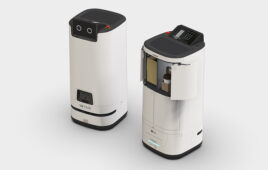|
Listen to this article
|

Stratom creates unmanned ground systems that move material in both controlled settings and expeditionary environments. | Source: Stratom
Stratom Inc. today announced that it is developing a “unique, small-form-factor material handling system.” It said its latest robot will be able to lift, load, unload, and transport palletized 463L tactical cargo across various operating environments and terrains.
The Louisville, Colo.-based company is participating in a Small Business Innovation Research (SBIR) Phase I project with the U.S. Special Operations Command (USSOCOM) and SOFWERX Inc.
The SBIR program funds a diverse portfolio of startups and small businesses across technology areas and markets. Its aim is to stimulate technological innovation, meet federal research and development needs, and increase commercialization.
“Building upon our prior expertise and knowledge in expeditionary robotic material handling, we’re helping define the appropriate tradeoffs of size, weight, capability and price to ensure our design is a strong fit for this application,” stated Jesse Weifenbach, lead vehicle systems engineer at Stratom.
“Integrating multiple proven technologies into a simplified, refined solution that streamlines USSOCOM and Air Force cargo operations and enhances warfighter safety, our innovative material-handling system will be lighter weight than traditional equipment, much quicker and efficient to deploy, and safer when unloading in undeveloped locations,” he added. “These unique capabilities enhance cargo operations while reducing fuel waste and minimizing cycle times for military personnel.”
“We have real-life integration experience, expanding from military deployments of rapid refueling and offroad autonomy,” Zachary Savit, senior manager for business development at Stratom, told The Robot Report.
New vehicle to be compact but powerful
Stratom is building a compact, remotely operated vehicle that will weigh less than 10,000 lb. (4,535.9 kg) and be airworthy. The company said the system will occupy just one pallet position while performing all cargo loading and unloading tasks for full-size, fully loaded 463L pallets in a variety of challenging conditions and locations.
“Without proper material handling equipment, alternate methods of combat cargo offloading consume significant time and are very labor-intensive while posing serious risks to personnel, materials, and the aircraft,” explained Mark Gordon, president and CEO of Stratom. “Plus, the current equipment used can weigh up to three times its payload capacity and occupies precious space within an aircraft.”
“The military is transitioning toward more agile combat employment in expeditionary environments and across large geographical footprints,” he said. “Consequently, the need for inexpensive, lightweight and flight-ready material-handling equipment that is immediately operational upon landing is required as assets are distributed across a greater range of isolated locations without sufficient infrastructure.”
Stratom builds on prior experience
Stratom has developed several autonomous ground vehicles and robotic systems for logistics and operational applications. Most recently, the company updated its Autonomous Pallet Loader (APL) in support of the U.S. Marine Corps.
The APL is a flexible, autonomous forklift that Stratom designed to transport heavy and bulky cargo across various terrains for both military and commercial use. The company said it is focused on maturing the integration of its Summit off-road autonomy architecture onto the APL.
Summit is a highly modular platform that enables customization for various container-loading applications. Stratom said this includes full automation of cargo operations for military aircraft.
Stratom has also designed the eXpeditionary Robotic Platform (XRP). This is an autonomous vehicle capable of driving in and out of an MV-22 Osprey aircraft while carrying more than 2,400 lb. (1,088.6 kg) of supplies.
On the other hand, Stratom’s eXpeditionary Robotic-Field Artillery Autonomous Resupply (XR-FAAR) can deliver ammunition and supplies to weapons systems.
Finally, SALT is Stratom’s small agile lift truck. The company said it aims to streamline Air Force aerial stores and munition-loading operations with the systems, increasing safety and enhancing adaptability.
“We’ve gotten a lot of feedback from recent trade shows, and we don’t yet know what other problems our products can solve,” said Savit. “We’re also looking at how our vehicles might fit in closed fleets, such as in mines.”







Tell Us What You Think!